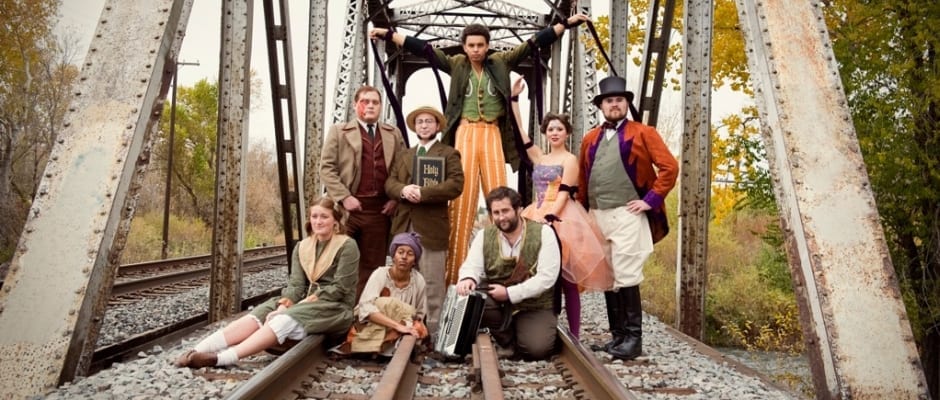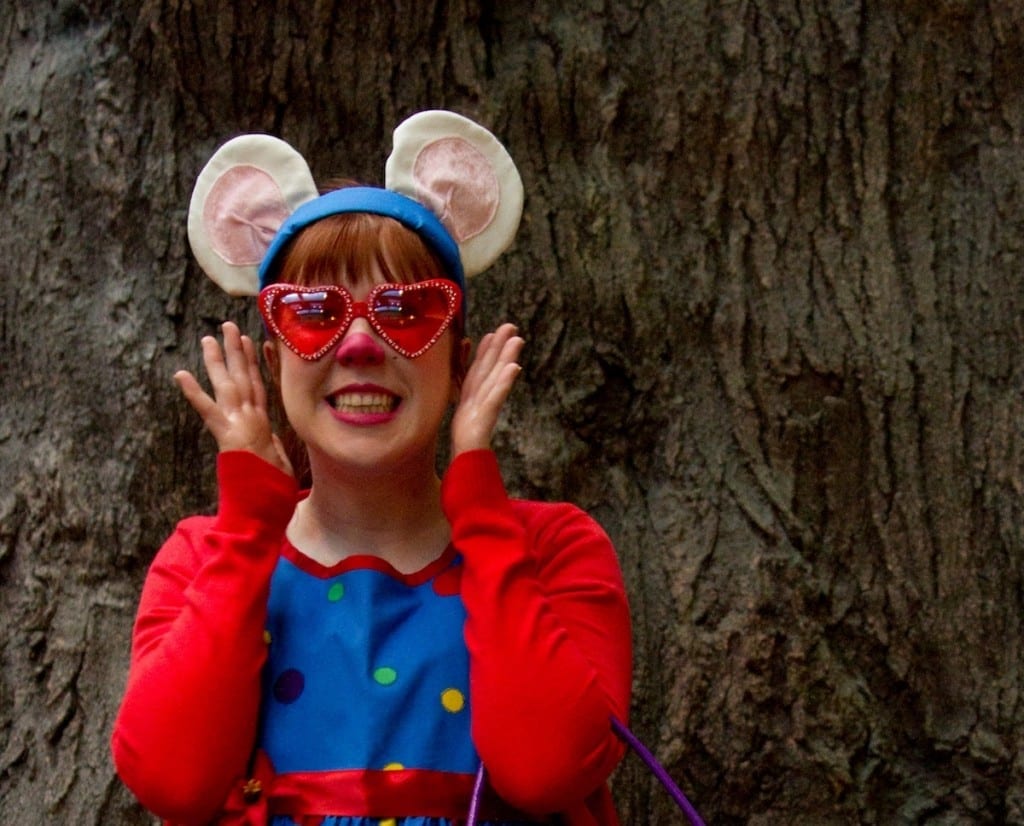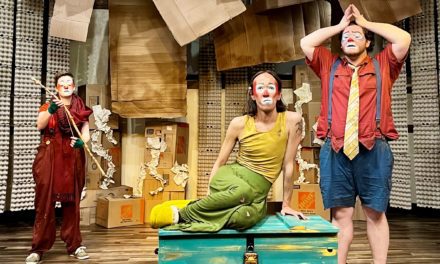OREM — There’s something different about UVU’s latest show, Elephant’s Graveyard. Sure, the actors never talk to each other and there are elephants onstage (look closely), but I’m talking about the absolute fire emanating from each person involved as they fight to get their story told.
Elephant’s Graveyard, written by George Brandt, is a unique piece, consisting entirely of monologues given by numerous characters that not only tell a story, but bring a town and an event to life. The year is 1916; Spark’s Circus comes to the small town of Erwin, Tennessee, complete with clowns, tight-rope walkers, a strong man, and—of course—elephants. Tragedy hits Erwin when the largest elephant, Mary, kills one of the circus workers and the town and circus folk decide what to do with a potentially dangerous animal.
The set will take your breath away when you first walk into UVU’s Noorda black box theater, but don’t let the magnitude stop you from appreciating its detail. Jared Lewis’s set design isn’t your basic town-front set, but rather carefully selected and detailed fragments of the would-be town placed in such a way as to let the audience fill in the missing pieces. This echoes the structure of the entire show, actually, as nothing is presented in complete, true-to-life action. We’re not getting the replays of what happened in Erwin like you would in your traditional play; rather we hear and see snippets of the story and get to construct the full happening ourselves. Don’t be discouraged, though; I guarantee the mental pictures you construct will be as vivid and as whole as any action you could witness.
I can’t rave enough about the immense care and thought that obviously went into this production. From the aforementioned set to the acting to the various designs (lighting design by Kirsti Bagle and Michael Gray, costume design by Allen Stout and Jannessa Law, makeup design by Rebeca Acosta), each element paved the way for a gorgeous and stirring story. Before any lines were spoken, a live band had their time to shine, setting the tone for the rest of the show. I commend music director Chase Ramsey and composer Willy Eklof along with the rest of the band for giving greater life and personality to the town of Erwin. The sound design enhanced our mental images throughout the show and was even the star of a few scenes. Plus, the music was just plain awesome.
During that pre-show music, I confess that I was praying the rest of the show would live up to its intensity—and thank goodness I can report that it did. Yes, the beginning was a little show and I was full of skepticism and critique, but as the story unfolded I forgot my pre-show fears and cynicism. Erwin’s citizens and the Spark’s Circus folk took me captive and didn’t let go the rest of the evening.
Speaking of which, the entire Graveyard ensemble stood strong. There were standouts, naturally, but this show would not have been successful had not every actor—even (especially) those that never spoke—been completely focused and honest. My only real criticism for the show comes is that at times accents weren’t the most polished. But once you let go and give yourself over to the story, that sort of thing fades into the background. The Ringmaster (played by Benjamin J. Henderson) absorbed my attention, mostly because I believed every word he said. He absolutely was the ringmaster whose word was absolute authority. The tour manager (Chase Ramsey) was just doing his best, trying to keep the circus smooth-running and lucrative. Daniel Fenton Anderson won our sympathy as the elephant trainer, and our hearts broke right along with his when his dear elephant was labelled a murderer. The ballet girl must have been an interesting character to explore (not that there was a character without depth or intrigue), and was artfully done so by Jacquelyne Jones; her character’s unwavering love for the elephant was both fascinating and heartbreaking. “Most improved” award for the night goes to the Muddy Townsperson (played by Caitlin Webb). I wasn’t enjoying her character much until the climactic scene I’ll label as the “penalty scene” when we witnessed a captivatingly honest change of heart from hate focused only on justice to sympathy and maybe even a little fear. It was so so human and overwhelmingly reflective of reality.
At first, I was disappointed that this incredibly detailed world was constructed in set and costume and character, but wasn’t fully inhabited. (That is to say, we got monologues, but no life. No interaction.), but by the end of the show I understood. Some shows are about characters; others are about emotions. This play was about a story, and what was happening onstage was pure and sincere storytelling. Every detail went into contributing to that story. Every word and movement and set dressing and prop existed for the sake and the good of the story.
On that note, THANK YOU FOR NOT HAVING A CURTAIN CALL. Again, the focus was on the story. I’ll even go so far as to say some of the focus was also on making the audience think. The focus wasn’t on the actors. It wasn’t about getting applause. When the last actor walked off the stage, the audience just sat. We reveled in what had just happened, in the story we had just witnessed. I’ve never heard a theater so silent. We must have sat there for at least a minute; it was electric.
To the cast of Elephant’s Graveyard, to director Terry Petrie, to the designers, to everyone involved in the process, thank you for a spellbinding night at the theater and for creating a unique show full of lasting images that I never saw. Thank you for making me think and reflect upon myself, upon the world, and upon who I want to be.







